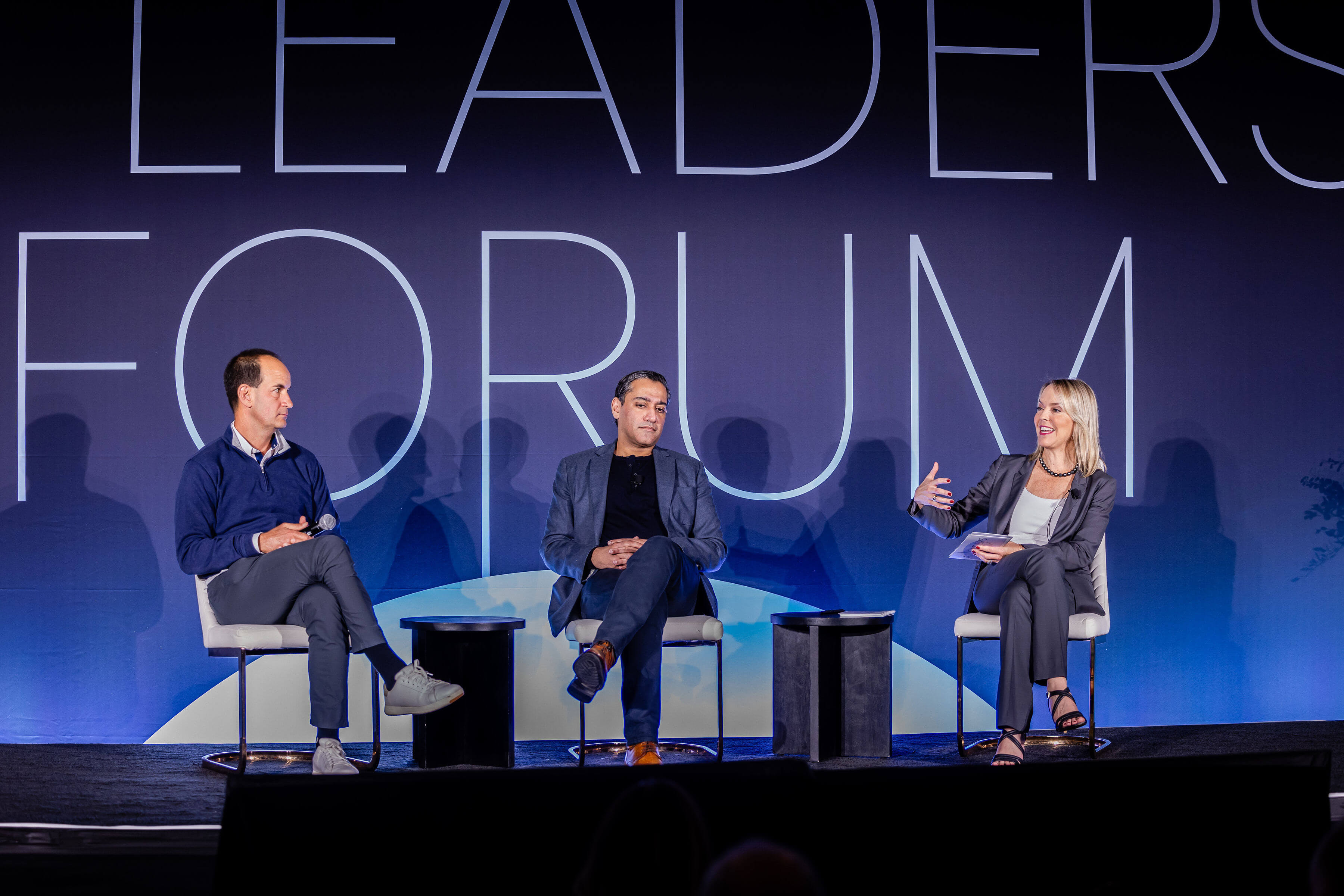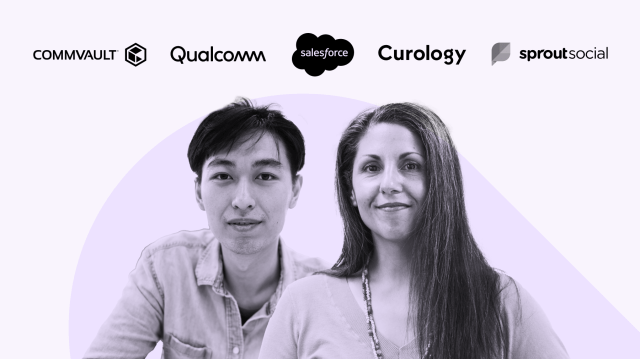Enterprise transformation
– 12 min read
AI Leaders Forum: Inside the playbook of the 6% winning AI at scale

On November 4, WRITER convened a select group of senior executives from the world’s leading companies for a closed-door AI Leaders Forum. The conversations were a candid look at the operational realities of enterprise AI — what works, what doesn’t, and what separates leaders from the laggards.
This is a strategic briefing on the insights that emerged from those conversations, intended for the executive who understands that the window of opportunity for AI leadership is closing. If you weren’t in the room, here’s what you missed.
- A vast majority of enterprises are stuck in AI pilot programs, creating a widening competitive gap with a small percentage of high-performing leaders.
- This failure often stems from the “category error” of treating AI as a traditional IT project instead of a fundamental redesign of business architecture.
- Successful companies adopt a “governance as guardrails” approach, using a secure platform to enable rapid innovation instead of blocking it with centralized control.
- True transformation is driven by empowering frontline employees to become builders who solve their own problems, shifting innovation to the “edges” of the organization.
- The ultimate goal is to augment, not replace, human experts, using AI to automate tedious work and free up teams for higher-order strategic thinking.
1. The scaling crisis: Why two-thirds of enterprises are being left behind
The latest State of AI report from McKinsey confirms a stark reality we see every day. While AI use is widespread, nearly two-thirds of organizations haven’t yet begun scaling AI across the enterprise.
They get stuck in pilot purgatory. The report identifies an elite group — the “AI high performers” who represent just 6% of companies — that are successfully capturing enterprise-level value. The leaders at our forum — from companies like Qualcomm Technologies, e.l.f. Beauty, and Marriott — are part of this 6%.

Their stories revealed a common thread, a “bias for action,” as Ekta Chopra, chief digital officer at e.l.f. Beauty, described it. It often starts with a single champion, like Brent Summers, who leads AI transformation at Qualcomm. His journey began as a personal curiosity that evolved into a company-wide initiative, demonstrating that escaping pilot purgatory often requires a catalyst from within. This mindset is the antidote to the scaling crisis.
2. The internal fracture: A “category error” is tearing companies apart
Why are so many companies stuck? Our 2025 enterprise AI adoption report, conducted in partnership with Workplace Intelligence, reveals a critical internal fracture: 42% of C-suite executives admit that AI is tearing their company apart.
The root cause, as our CEO May Habib, identified at the forum, is a fundamental “category error.” Most organizations defaulted to their old IT playbook, handing the AI mandate to technology departments. This approach is failing because it misunderstands the nature of the shift.
“For 100 years, enterprises have been built around the idea that execution is expensive and hard,” Habib explained. AI flips that model entirely. “Execution is going from scarce and expensive to programmatic, on-demand, and abundant.”

AI isn’t an IT project. Instead, it’s a complete redesign of business architecture. Delegating it to a department that can’t unilaterally re-architect cross-functional workflows is the single biggest mistake an enterprise can make. It’s the source of the C-suite friction, and it’s the anchor weighing down most AI initiatives.

It’s a problem that starts at the very foundation. As Yusuf Tayob, CEO of the 7,000-person consulting firm Proficient, candidly admitted on stage, “In our own company and in our own journey to become AI first, our data sucks… and you really can’t unlock the power of everything we’re talking about without good data.” This admission from an expert highlights a universal truth. Even with the right strategy, foundational data work is a prerequisite to success.
2. The governance shift: From gates to guardrails
The leaders at the forum were unanimous in their feelings that traditional, centralized governance models are failing. The old way — where IT holds the keys and innovation gets bottlenecked by slow, bureaucratic processes — is a death sentence in the age of AI. The high performers are flipping the model.
This shift is about establishing governance as guardrails, not gates. It’s about creating a secure, compliant, and on-brand sandbox where teams are free to build. This is where a full-stack platform becomes non-negotiable. When your models, your data, your controls, and your user-facing applications all live in one environment, you can enforce rules — like voice or regulatory disclosures — at the point of creation.

This requires a new mental model for supervising AI, as Matan-Paul Shetrit, our head of product, has observed. He argues that we must manage agents not as APIs to monitor, but as a “synthetic workforce” to supervise. Instead of just tracking metrics, this means giving agents the equivalent of job descriptions, clear escalation paths, and access controls, just as you would with a human employee. A supervision-focused framework makes it possible to scale thousands of agents while maintaining control and accountability.. It’s this platform-based approach that turns governance into a source of velocity, not a roadblock.
3. The orchestration shift: From top-down mandates to empowering the edges
The leaders at the forum aren’t just implementing AI. They’re rewiring their organizations around it. This requires three foundational shifts in thinking:
Shift 1: From technology projects to business transformation
The most common mistake is treating AI as another IT project. The high performers see it as a catalyst for complete business transformation. For them, it’s about fundamentally rethinking how work gets done.
Paul Dyrwal, who leads generative AI at Marriott, framed this as a battle against “entropy” — the natural tendency for business processes to decay and become inefficient over time. “The job here is to find ways to get humans and AI to work together through these value chains to drive down entropy,” he explained.

This requires looking at the entire workflow, not just isolated tasks. It’s a shift from asking “What can this tool do?” to “What business problem can we solve?” This is precisely the approach that enables platforms like WRITER, which are designed not as point solutions but as integrated systems that allow companies to build and deploy AI across their most critical workflows.
This shift demands more than just a change in mindset. It requires a new class of technology. This is why the conversation is moving from simple chatbots to autonomous AI agents. As seen in a recent VentureBeat report, leading firms are already using WRITER agents to execute complex, multi-system workflows, like generating investment reports by pulling data from Snowflake, SEC filings, and real-time web searches. This is empowerment in action.
Shift 2: From Centralized Control to Governance as Guardrails
The old model of IT handing down rigid, one-size-fits-all technology solutions is no longer effective. In the AI era, the winning strategy is about enablement. This requires a new kind of governance that acts as guardrails instead of gates.
No one articulated this better than Adam Sinensky, CTO of Aptitude Health, a company that operates in the highly specialized and regulated field of oncology intelligence. His primary challenge was earning the trust of his team of PhDs and MDs, who were rightly skeptical. “The question was always, ‘Can agentic AI really do that?’” Sinensky shared, emphasizing the deep domain expertise required.

His team’s solution was a methodical, trust-first approach that serves as a playbook for any leader in a complex industry:
- Earn the “permission slip”: Before any talk of ROI, Sinensky’s team had to prove the technology’s credibility. In just one week, they worked with WRITER to run a past project through a custom AI agent. They compared the agent’s output to the human-generated report. The verdict from his VP of scientific content? The agent was “as good or better.” That success was the “permission slip” needed to move forward.
- Focus on augmentation, not replacement: The goal was never to replace their scientific experts. “It’s not replacing me,” Sinensky said, echoing his team’s sentiment. “It’s actually replacing the stuff I don’t want to be doing.” By automating the tedious work of summarizing hundreds of pages of transcripts, he enabled his experts to focus on higher-order strategic analysis.
- Build for the workflow: The solution wasn’t a generic chatbot. It was a custom agent built in WRITER, tailored to Aptitude Health’s specific inputs (transcripts, polling data), and desired outputs (executive summaries, detailed takeaways). This bespoke approach ensured the technology fit the expert, not the other way around.
This is governance as guardrails in action. It’s about providing a secure, compliant, and customized platform that empowers experts to build, test, and scale solutions with confidence.
Shift 3: From centralized control to empowered edges
The second shift is a move away from a top-down, centralized model of innovation. The leaders at our forum are not just building AI for their employees — they’re empowering their employees to become builders themselves.
“You have to find your fire starters,” urged Eric “E.T.” Trowbridge from Blue Federal Credit Union, who has driven remarkable AI innovation with a lean team. He gives his two developers dedicated “AI Fridays” to experiment and build. “If I can do it with zero [dedicated] employees… you can do it too.”

This creates a powerful, decentralized engine for innovation. Dyrwal identified two types of builders: the “engineers” who work on complex, at-scale systems, and the “non-engineers” — the marketers, the analysts, the operations managers, who are closest to the ground truth and can build their own solutions to solve their own problems. This is where a full-stack platform like WRITER becomes essential, providing both the enterprise-grade APIs for engineers and the intuitive, no-code interfaces for business users to create their own AI agents and workflows.
This shift is about democratizing innovation. It’s about giving the people closest to the customer and the workflow the tools to build their own solutions.
The journey of Summers at Qualcomm is a prime example. As a marketing leader, not an IT specialist, he became an “early WRITER champion” and fundamentally altered the trajectory of his career and his company’s marketing operations. He didn’t wait for a top-down mandate; he saw a need and began to “break a lot of it apart and make them rethink.”
By building and championing AI solutions from within his own department, he created a grassroots movement that led to massive strides in efficiency and creativity. This is the new model for enterprise transformation — it’s not dictated from the C-suite, but cultivated at the edges of the organization.
The platform that enables this must be built for it. It requires an architecture like WRITER’s, where a secure, common knowledge base and set of models can be used by teams across the company to build their own agents and applications, ensuring consistency and compliance without stifling innovation.
This isn’t just a process change — it’s an architectural one. A platform must be built with governance at its core, not as an afterthought. In a recent interview, Habib emphasized that “accuracy is the cornerstone,” explaining that the platform is engineered to reduce hallucination, expose its reasoning, and cite its sources. This is the foundation of trust that allows teams to move fast and with confidence.
Shift 4: From AI as replacement to AI as augmentation
The fear of replacement is real, but the leaders at the forum are focusing on augmentation. They’re building systems to enhance the capabilities of their best people rather than replace them.
Chopra shared a perfect example from e.l.f. Beauty — “90% of our community comments are AI-generated, but human-touched.” The AI handles the initial draft, but a human provides the final approval and nuance. This frees up her team to focus on higher-value strategic work.

Dyrwal offered a powerful analogy — If you give an AI music generator to a random person and to Paul McCartney, who will make a better song? “We all know the answer,” he said. “Humans are very necessary in the judgment that we bring to the equation.”
An enterprise AI platform should function as a tool that strengthens human expertise and supports informed judgment. This is the core design philosophy behind WRITER’s architecture — to create a system that enhances, rather than supplants, human ingenuity.
This shift from building point solutions to orchestrating systems is why a full-stack platform is no longer a luxury but a necessity. A true platform connects to and reasons across the entire data ecosystem. The investment firm mentioned earlier isn’t just using an AI tool — they are using a platform that orchestrates data from their internal data warehouse (Snowflake), public documents (SEC filings), and the live web to create something entirely new. That is the future of enterprise AI.
Your First 90 Days: A Tactical Guide
How do you start? The journey begins with a 90-day sprint focused on a single, high-value business outcome.
- Days 1-30: Assemble your AI steering committee. This isn’t an IT task force. Pull in your most forward-thinking leaders from marketing, operations, and finance. Your only agenda item — “What is the single most valuable business outcome we could drive with AI?”
- Days 30-60: Identify and empower your “AI champion.” Find a domain expert who is obsessed with solving that business problem and give them the tools and authority to build a solution.
- Days 60-90: Deploy and measure. Launch the first version of the AI solution and measure its impact against the business outcomes you defined on day one. This creates the momentum needed for the next wave of transformation.
The new competitive advantage
The conversations at the AI Leaders Forum made one thing clear. The divide between the companies that “use” AI and those led by it is widening at an accelerating rate. The latter aren’t just implementing technology — they’re building a new kind of organization — one that’s more agile, more creative, and more deeply connected to its customers.
This is more than a technology investment. It’s a leadership challenge, a talent strategy, and an organizational redesign. For those who embrace it, the advantage will be compounding and, soon, insurmountable. For those who don’t, the risk is no longer stagnation — it’s irrelevance.
The question for leaders today isn’t if AI will transform their business, but if they have the clarity and courage to lead it.


